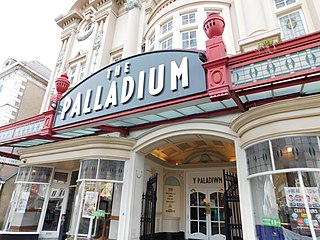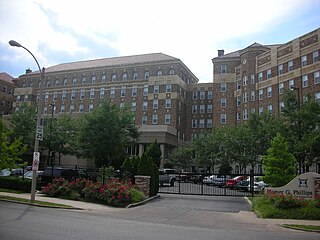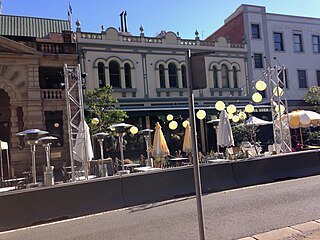
J D Wetherspoon plc is a pub company operating in the United Kingdom and Ireland. Founded in 1979 by Tim Martin and based in Watford, the company operates 925 pubs as of June 2021. This includes the sub-brand of Lloyds No.1 bars, and around 50 Wetherspoon hotels. Wetherspoon is known for converting unconventional premises into pubs, such as former cinemas and banks. The company is publicly listed on the London Stock Exchange and is a constituent of the FTSE 250 Index.

The Queen's Medical Centre is a teaching hospital situated in Nottingham, England. Until February 2012, when it was surpassed by the Royal London Hospital, it was the largest hospital in the United Kingdom. It is managed by Nottingham University Hospitals NHS Trust.

The Angel, Islington, is a historic landmark and a series of buildings that have stood on the corner of Islington High Street and Pentonville Road in Islington, London, England. The land originally belonged to the Clerkenwell Priory and has had various properties built on it since the 16th century. An inn on the site was called the "Angel Inn" by 1614, and the crossing became generally known as "the Angel". The site was bisected by the New Road, which opened in 1756, and properties on the site have been rebuilt several times up to the 20th century. The corner site gave its name to Angel tube station, opened in 1901, and the surrounding Angel area of London.

The Museum of English Rural Life, also known as The MERL, is a museum, library and archive dedicated to recording the changing face of farming and the countryside in England. The museum is run by the University of Reading, and is situated in Redlands Road to the rear of the institution's London Road Campus near to the centre of Reading in southern England. The location was formerly known as East Thorpe House and then St. Andrews Hall. It is an accredited museum and accredited archive as recognised by Arts Council England and the National Archives.

Saint Mary's Hospital is a hospital in Manchester, England. It is part of Manchester University NHS Foundation Trust. Founded in 1790, St Mary's provides a range of inter-related services specifically for women and children.

Sherwood is a large district and ward of the city of Nottingham, in the English ceremonial county of Nottinghamshire. It is situated approximately 1.5 miles (2.4 km) north of Nottingham city centre. The population of the ward taken at the 2011 census was 15,414. It is bordered by Woodthorpe to the northeast, Mapperley to the east, Carrington to the south, New Basford and Basford to the west, and Daybrook and Bestwood to the north.

The Royal Infirmary of Edinburgh, or RIE, often known as the Edinburgh Royal Infirmary, or ERI, was established in 1729 and is the oldest voluntary hospital in Scotland. The new buildings of 1879 were claimed to be the largest voluntary hospital in the United Kingdom, and later on, the Empire. The hospital moved to a new 900 bed site in 2003 in Little France. It is the site of clinical medicine teaching as well as a teaching hospital for the University of Edinburgh Medical School. In 1960, the first successful kidney transplant performed in the UK was at this hospital. In 1964, the world's first coronary care unit was established at the hospital. It is the only site for liver, pancreas and pancreatic islet cell transplantation and one of two sites for kidney transplantation in Scotland. In 2012 the Emergency Department had 113,000 patient attendances, the highest number in Scotland. It is managed by NHS Lothian.

Michael Reese Hospital and Medical Center was an American hospital located in the Bronzeville neighborhood of Chicago, Illinois. Founded in 1881, Michael Reese Hospital was a major research and teaching hospital and one of the oldest and largest hospitals in Chicago, Illinois. It was located at 2929 S. Ellis Avenue on the near south side of Chicago, next to Lake Shore Drive which lies along Lake Michigan. The hospital closed its Internal Medicine Residency at the end of the 2007–2008 academic year and finished transferring patients to Mercy Hospital and Medical Center before the end of 2008. The 48-acre campus was then vacated by January 2009. From 2007 to its closing, Michael Reese had been owned by Envision Hospital Corporation of Scottsdale, Arizona. The hospital officially closed August 31, 2009. At one time, the hospital had a large health plan which included 300,000 patients; at the time of the hospital's closure the health plan was terminated and it only had 2,900 clients. The streets through the campus were closed and demolition began in October 2009.

Nottingham General Hospital was a major hospital in Nottingham, England. It was founded in 1781 and closed in 1992.

University Hospital Lewisham is an acute district general hospital run by Lewisham and Greenwich NHS Trust and serving the London Borough of Lewisham. It is now affiliated with King's College London and forms part of the King's Health Partners academic health science centre. It is situated on Lewisham High Street between Lewisham and Catford.

Homer G. Phillips Hospital was the only public hospital for African Americans in St. Louis, Missouri, from 1937 until 1979, when the city still had segregated facilities. Located at 2601 N. Whittier Street in The Ville neighborhood, it was the first teaching hospital west of the Mississippi River to serve the city's Black residents.

The Royal Waterloo Hospital for Children and Women was a hospital located on the corner of Waterloo Bridge Road and Stamford Street near Waterloo station in London, England. Closed in 1981 it is now a dormitory building for the London branch of the University of Notre Dame.

Castle Gate Hospital was a women's hospital at 29-31 Castle Gate in Nottingham, England.

The Samaritan Hospital was a hospital in Raleigh Street, Nottingham, England.

Providence Hospital was a 408-bed hospital located in the District of Columbia, United States. Founded in 1861 on Capitol Hill by the Roman Catholic Daughters of Charity of Saint Vincent de Paul, it was the longest continuously operating hospital and the last public hospital in the District. It moved to Brookland in 1956. Providence Hospital was a member of Ascension Health, the largest non-profit health care organization in the United States.
The Karitane Hospitals were six hospitals in New Zealand run by the Plunket Society, located in Auckland, Christchurch, Dunedin, Invercargill, Wanganui and Wellington. They were established as training hospitals for Karitane nurses and cared for babies with malnutrition and other dietetic complaints, and premature babies. They also offered mother care training and assistance. The first hospital opened in 1907 and the hospitals were closed between 1978 and 1980 due to financial difficulties and changes in society and maternity services.

121 George Street, The Rocks is a heritage-listed retail building and former terrace house and shops located at 121 George Street, in the inner city Sydney suburb of The Rocks in the City of Sydney local government area of New South Wales, Australia. It was built during 1880 for Thomas Playfair. It is also known as Baker's Oven - Shop and residence. The property is owned by Property NSW, an agency of the Government of New South Wales. It was added to the New South Wales State Heritage Register on 10 May 2002.

The Golden Beam is a pub and Grade II listed building located in the Headingley area of Leeds, West Yorkshire, England. It was built in c. 1912 for the Church of Christ, Scientist, and was known as the Elinor Lupton Centre from 1986 to 2010 when it was a school arts centre. It was designed by Piet de Jong and William Peel Schofield from the architectural firm Schofield and Berry. Constructed in white Portland stone in a mixed style of Egyptian Revival and Art Deco, it was originally built as a Sunday school in c. 1912–1914, extended in the 1930s with a church building and then used by the Leeds Girls' High School as a theatre and music centre from 1986 until 2010. The structure has architectural significance in the locality due to its distinct style and use of materials; many original features and fittings survive, including the entrance foyer, two staircases and a glazed lantern in the auditorium roof.



















